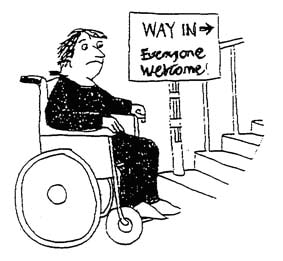Table of Contents
The Paralympics have made an incredible impact on society and has got people talking positively about disability!
Understanding the medical and social model of disability is important not just for people directly involved with a child or adult with a disability but for everyone in society in order to build positive attitudes and a better understanding. Here is a short assignment I wrote a few years ago whilst studying inclusion and disability.
Understanding the Medical and Social Model of Disability
Over time, our society’s perceptions of disability has evolved from the idea of complete segregation of disabled people, where the problem is seen as the person’s impairment or malfunction, to the model of inclusion where everyone has equal access to the same services and society is viewed as the problem causing barriers which inevitably disable people. As the disabled author Mason (2000) states “segregation holds out a model of punishment, devaluing and isolation as society’s response to… disability and because this could happen to anyone, we all live in fear and dread of it being us”. Mason suggests just how important inclusion can be in order for society to build a positive understanding of disability and so that everyone can be seen as equal and not inferior or superior to others. The two main models of disability which have influenced thinking are the medical and social model.
The medical model of disability
The medical model of disability sees the person as the problem and unable to join in with society as a result of their  impairment and not as a consequence of the features in our society which could be changed. The medical model also suggests the disabled person should be ‘cured’ by the medical profession. Mackenzie (2005) suggests that “many disabled people internalise the negative message that all disabled people’s problems stem from not having ‘normal’ bodies”. The medical model therefore can influence the way disabled people think and feel about themselves and can cause feelings of low self-esteem. This can then lead people to believe that their impairments stop them from participating in society, which can eventually lead to further segregation and exclusion. The medical model approach puts an emphasis on personal tragedy which has developed negative language towards disabled people such as “I will ‘help’ that ‘poor’ disabled person”. The medical model gives an idea of charity and that disabled people require help. The weaknesses of disabled people are focused on instead of their strengths, goals and dreams.
impairment and not as a consequence of the features in our society which could be changed. The medical model also suggests the disabled person should be ‘cured’ by the medical profession. Mackenzie (2005) suggests that “many disabled people internalise the negative message that all disabled people’s problems stem from not having ‘normal’ bodies”. The medical model therefore can influence the way disabled people think and feel about themselves and can cause feelings of low self-esteem. This can then lead people to believe that their impairments stop them from participating in society, which can eventually lead to further segregation and exclusion. The medical model approach puts an emphasis on personal tragedy which has developed negative language towards disabled people such as “I will ‘help’ that ‘poor’ disabled person”. The medical model gives an idea of charity and that disabled people require help. The weaknesses of disabled people are focused on instead of their strengths, goals and dreams.
Often the lives of disabled people are handed over to the medical profession or more usually to non-disabled professionals. This is because it is the professionals who usually determine where disabled people go to school, what type of education they receive, where they may live, where they can work and sometimes whether they are born at all. Adults with disabilities living in a society that is primarily approached though a medical model may find themselves segregated away into institutions, group homes, sheltered workshops, adult training centres and special hospitals. This can hinder their opportunities to find employment and access to choices. Their lives will more or less be determined for them by medical professionals. Consequently, disabled people will not be able to break out of the cycle that they are ‘in need’ and ‘need care’ and will probably therefore be taken care of for the rest of their lives. The medical model creates an unequal and exclusive society.
The social model of disability
The social model of disability sees society itself as disabling by not adapting to the needs of everyone. For example, there are such issues as unequal job opportunities and poor access to services which causes discrimination towards disabled people. Johnstone (2001) suggests that “it is society that perpetuates the oppression and exclusion of disabled people… the onus of responsibility is shifted from the individual with an impairment or disability to the restrictions imposed by the construction of the social and physical environment and the attitudes of institutions and organisations”.
The social model of disability emphasises the importance of inclusion. By removing the barriers society places on disabled people such as lack of access to jobs and services, inclusion can start to happen. Inclusion is where everyone, no matter what their ability, is treated equally and is included in all activities. According to Thomas and Loxley (2001) inclusion is about “comprehensive education, equality and collective belonging… The notion of inclusion therefore does not set boundaries around particular kinds of supposed disability.” Therefore, the social model gives the idea that disability is the collective and shared responsibility of society as a whole and that disabled people are a part of our varied and diverse society.
References:
- Mason, M. (2000) Incurably Human.London: The Working Press
- Johnstone, D. (2001) Introduction to Disability Studies.London: David Fulton
- Thomas, G and Loxley, A (2001) Deconstructing special education and constructing inclusion. Buckingham : Open University
- Mackenzie, K. (2005) http://www.staffcentral.brighton.ac.uk/clt/disability/#models accessed 21/11/05

